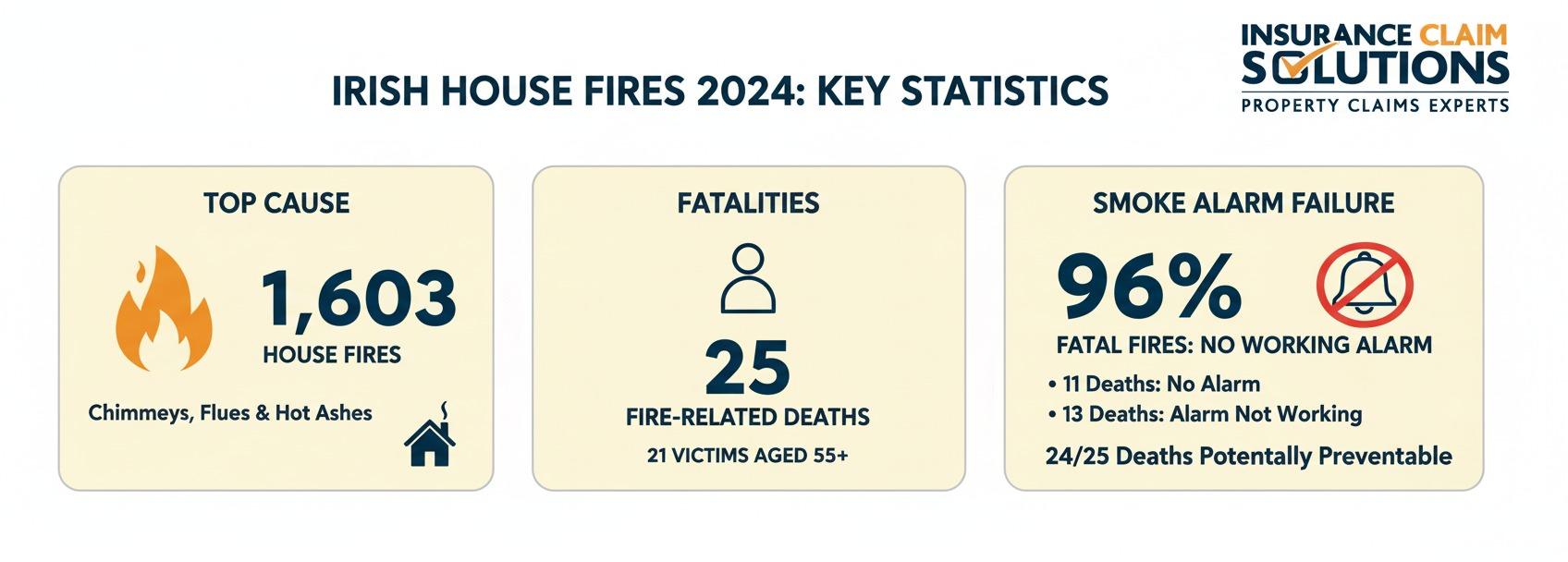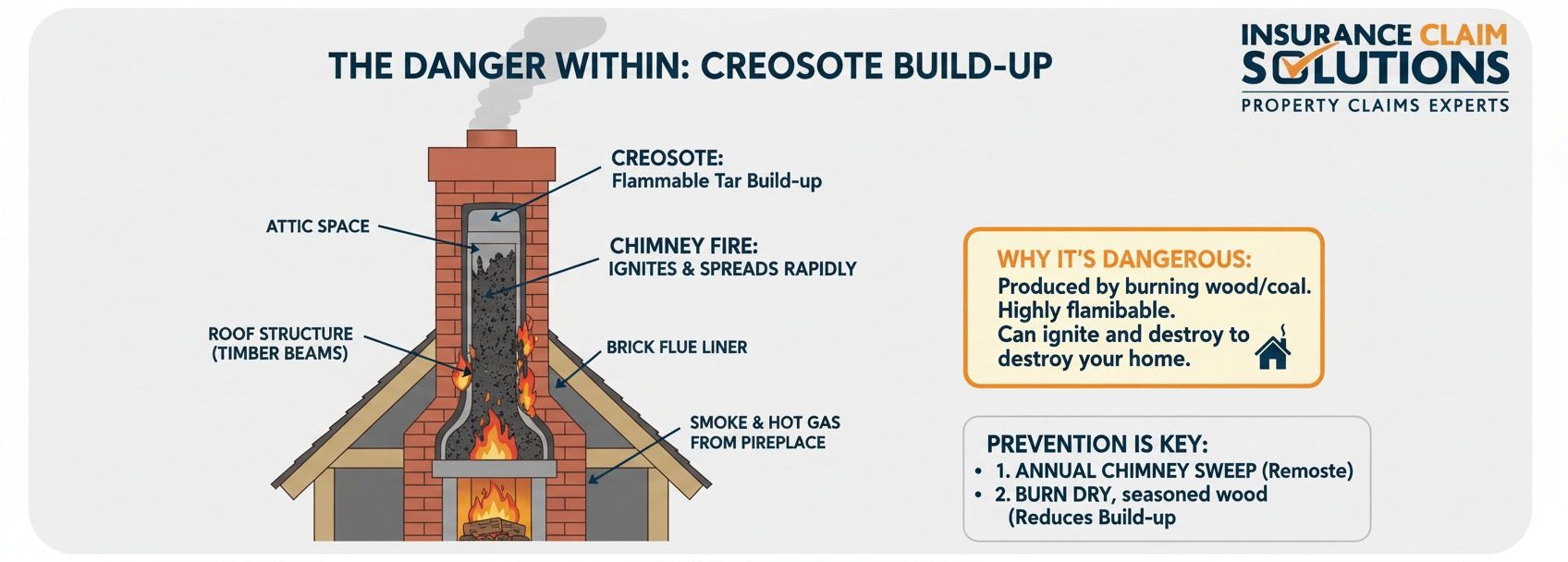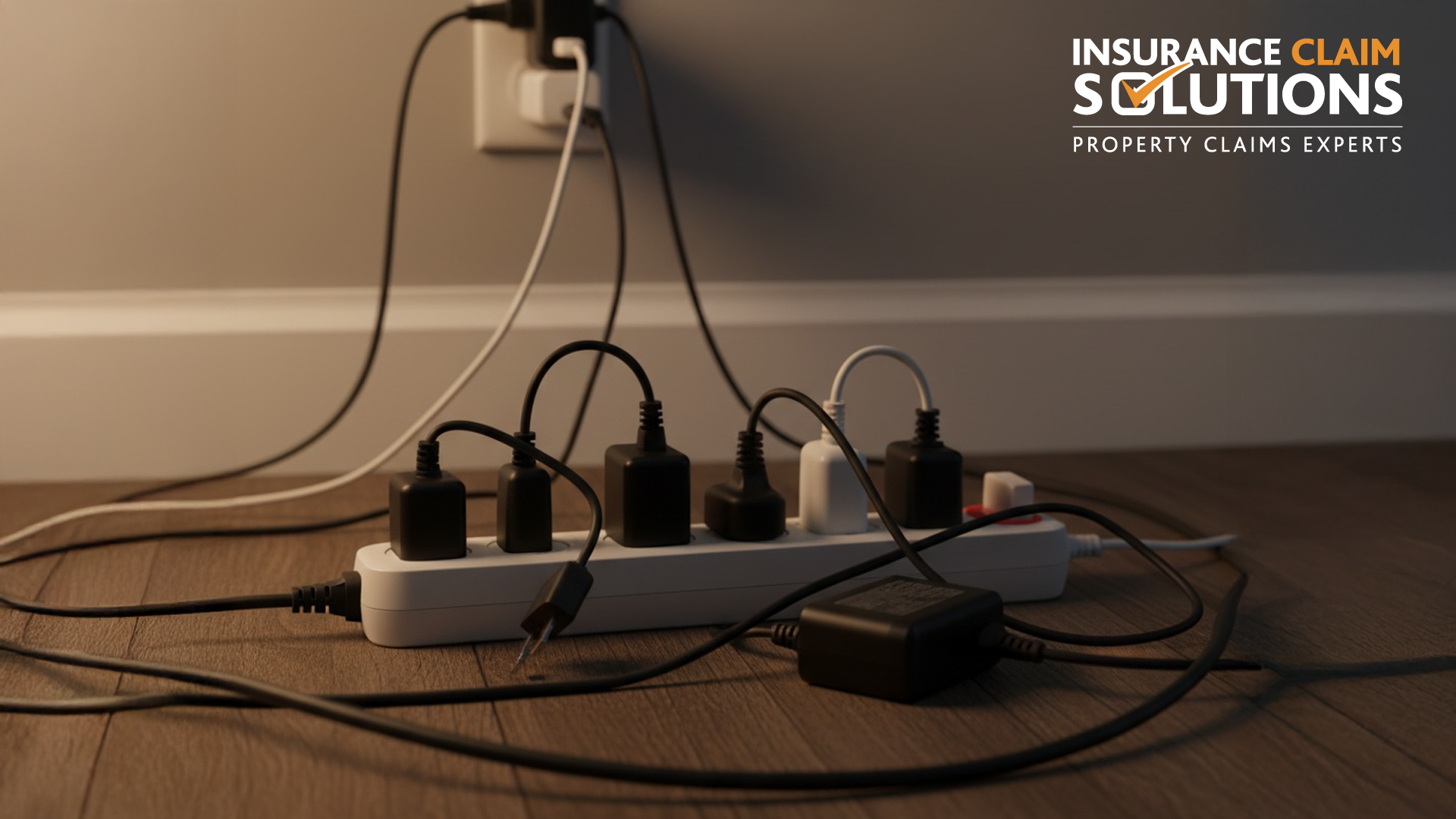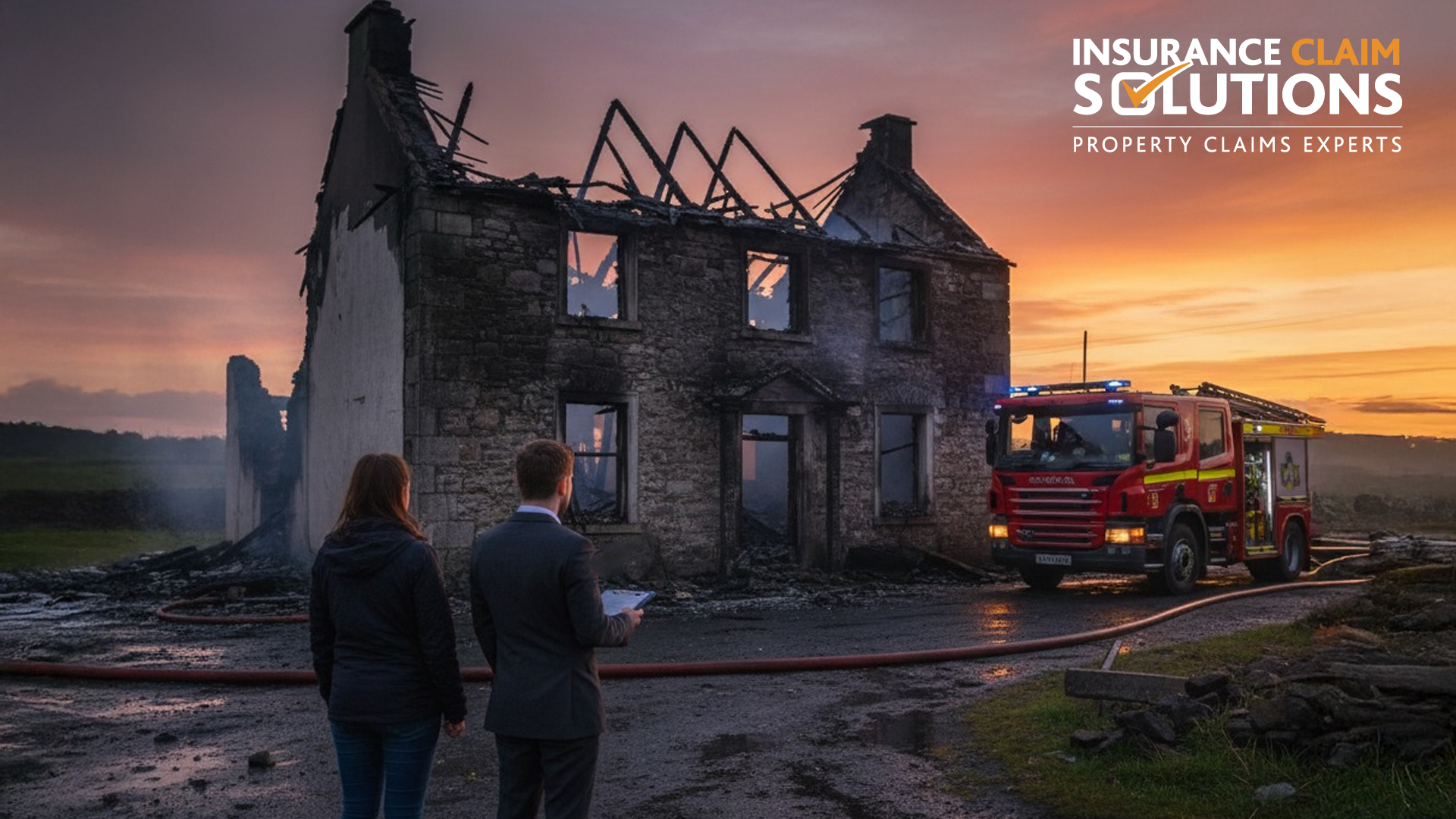A house fire can destroy a home in minutes, but the financial and emotional consequences last for years. While our complete guide to fire damage claims explains how to navigate the aftermath, prevention is the best strategy.
Understanding the actual causes of house fires, based on the latest national fire statistics, is the first step toward protecting your family and property. Proactive prevention is also critical for ensuring your home insurance policy responds fully if a disaster occurs.
Irish House Fires in 2024: The Key Statistics
- Top Cause: Chimneys, flues, and hot ashes caused 1,603 house fires—more than all other known causes combined.
- Fatalities: There were 25 fire-related deaths in Irish homes, with 21 of the victims being aged 55 or over.
- The Smoke Alarm Failure: Of the 25 fatalities, 11 occurred in homes with no smoke alarm, and 13 occurred where an alarm was present but not working. A working smoke alarm could have made a difference in 24 out of 25 deaths.

Why Fire Prevention Strengthens Your Insurance Claim
As the data shows, many fires are preventable. Insurance policies are contracts based on your taking reasonable care of your property. If a fire is found to be caused by clear negligence—such as a chimney that hasn’t been cleaned in years—it can give an insurer grounds to reduce your settlement or, in severe cases, deny the claim entirely.
Keeping records of maintenance, like chimney cleaning receipts and electrical inspection certificates, is powerful evidence that you are a responsible homeowner and will strengthen your position during the claims process.
The Main Causes of House Fires in Ireland (Based on Data)
Here are the most common fire risks in Irish homes, with expert advice on prevention and the insurance implications of each.
1. Chimneys, Flues, and Hot Ashes (37% of Fires)
The Risk: Official data confirms this is the single biggest cause of house fires in Ireland. When wood or coal burns, it releases a flammable residue called creosote, which builds up inside your chimney flue. This tar-like substance can ignite, sending a fire roaring up the flue and into your attic and roof structure with devastating speed.
 A diagram showing creosote build-up inside a chimney flue.
A diagram showing creosote build-up inside a chimney flue.
Prevention Checklist:
- Get Your Chimney Swept Annually: This is non-negotiable. A professional will remove dangerous creosote buildup. Keep the receipt as proof of maintenance.
- Burn Seasoned Hardwood: Use dry, seasoned wood. Damp wood produces more smoke and accelerates creosote buildup.
- Dispose of Ashes Safely: Hot ashes can smoulder for days. Place them in a metal container away from the house before disposing of them.
- Use a Fireguard: Always use a guard to prevent sparks from igniting carpets or furniture.
Insurance Insight:
In the event of a chimney fire, one of the first things an insurance adjuster will ask for is proof of regular cleaning. Failure to provide it can be interpreted as negligence and may jeopardise your claim.
2. Malicious Intent & Rubbish Burning (15% of Fires)
The Risk: Deliberately setting fires and the improper burning of household or garden waste are the second most common cause of residential fires. This includes bonfires getting out of control or arson attacks.
Prevention Checklist:
- Never Burn Household Waste: It is illegal and unsafe. It can release toxic fumes and easily spread.
- Secure Your Property: Keep gates locked and bins stored securely away from the walls of your home to deter malicious acts.
- Be Cautious with Bonfires: If you have a bonfire, ensure it is far from fences, sheds, and your house, and never leave it unattended.
3. Electrical Faults
The Risk: Faulty wiring, overloaded sockets, and failing appliances are a frequent source of accidental fires. This is a particular risk in older homes where electrical systems aren’t designed for the demands of modern electronics.

Prevention Checklist:
- Don’t Overload Sockets: Use multi-socket extensions sparingly and never plug one into another (“daisy-chaining”).
- Schedule Professional Inspections: Have a registered electrician inspect your wiring every 5-10 years.
- Check Appliance Cords: Replace any frayed or damaged electrical cords immediately.
- Unplug When Not in Use: Unplug smaller appliances and chargers when you’re not using them, especially overnight.
4. Cooking Accidents
The Risk: The kitchen remains a high-risk area. Unattended cooking is the primary cause, with grease fires being especially dangerous as they erupt in seconds and are difficult to control.
Prevention Checklist:
- Never Leave Cooking Unattended: This is the golden rule. If you must leave the room, turn off the hob.
- Keep Your Cooker Clean: Regularly clean your hob, oven, and grill to prevent a build-up of flammable grease.
- Have Safety Equipment Ready: Keep a fire blanket and fire extinguisher in the kitchen and know how to use them.
5. Smoking Materials (Associated with 20% of Fatalities)
The Risk: While not the most frequent cause of fires, smoking is linked to a disproportionately high number of deaths. A cigarette can smoulder for hours in a sofa, mattress, or bin before bursting into flames, often while residents are asleep.
Prevention Checklist:
- Never Smoke in Bed.
- Use Deep, Heavy Ashtrays: Make sure they are stable and can’t be knocked over.
- Extinguish Fully: Douse cigarettes with water before putting them in the bin.
- Smoke Outdoors: The safest policy is to smoke outside.
Bonus: Don’t Forget Seasonal Fire Risks
Fire risks change throughout the year. Here’s what to watch out for each season.
Winter Risks
- Christmas Decorations: Overloaded sockets with lights and faulty wiring on older decorations are a major hazard. Always turn them off when leaving the house or going to bed.
- Increased Heater Use: Portable heaters placed too close to furniture, curtains, or bedding can easily cause ignition. Maintain a one-metre clear zone.
- Open Fires: More frequent use of fireplaces increases the risk of chimney fires and stray sparks. Ensure your chimney has been swept.
Summer Risks
- Barbecues: Hot coals can stay hot for hours. Ensure they are fully extinguished with water before you leave them. For gas BBQs, check for leaks before use.
- Garden Fires: Bonfires for garden waste can quickly spread to fences, sheds, or even your home in dry, windy conditions.
Autumn Risks
- Halloween Candles: Candles in pumpkins or used as decorations are a significant risk. Place them away from flammable costumes and consider using LED alternatives.
- Leaf Buildup: Dry leaves accumulating in gutters can be ignited by sparks from a chimney. Keep your gutters clear.
Your 3-Point Fire Prevention Plan: Key Takeaways
- Sweep Your Chimney Annually: It’s the #1 cause of house fires. Book a professional and keep the receipt.
- Test Your Smoke Alarms Weekly: A working alarm is your best defence. Test the button every week and change the batteries once a year.
- Have Your Electrics Inspected: If your home is over 10 years old, a professional electrical inspection can prevent hidden dangers.
The Critical Role of Smoke Alarms: The Data Doesn’t Lie
The 2024 statistics paint a stark picture: in 96% of fatal house fires, a working smoke alarm was not present.
- 11 deaths occurred in homes with no alarm fitted.
- 13 deaths occurred in homes where an alarm was fitted but was not working (due to a dead battery or a fault).
A working smoke alarm is the single most effective piece of fire safety equipment you can own. It provides the crucial early warning needed to escape.
Action Plan:
- Install Alarms: Fit at least one smoke alarm on each level of your home. Use a heat alarm in the kitchen.
- Test Weekly: Press the test button every week to ensure the alarm is working.
- Change Batteries Yearly: Never remove the batteries from your alarm.
What to Do If a Fire Happens Anyway
Even with the best precautions, accidents can occur. If a fire breaks out, your immediate priorities are safety and evacuation.
- Get Out, Stay Out, Call 999 or 112.
- Once you are safe and the fire is out, the claims process begins.
Navigating the complexities of documenting damage, interpreting your policy, and negotiating with your insurer’s loss adjuster can be overwhelming. This is where professional help is invaluable.
For a step-by-step guide on what to do in the aftermath of a fire and how to manage your insurance claim effectively, please see our comprehensive guide: Fire Damage Claims Ireland: The Complete Guide.


